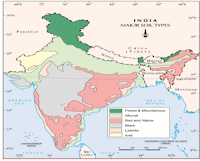Geography: Types of Soil in India | Soil in India | Types of Soil
ssc preparation, important competetion questions, current affairs of india, latest question asked in competetion papers,
- Alluvial Soil in India (Inside Black line in map)
- This soil coveratleast 40 % area of India.
- Occupy the plains ( from Punjab to Assam ) and also occur in the valleys of Narmada and Tapti in M.P. & Gujarat, Mahanadi in the MP and Orissa, Godawari in A.R and Cauvery in T.N.
- This is divided into two types: a) Khadar ( newly formed alluvial soil ) b) Bhangar (old alluvial soil).
- rich in Lime, Potash and Alluvium but deficit in nitrogen and humus.
Characteristics of Alluvial soil:
- Respond well to irrigation and manuring.
- Good for both rabi and kharif crops.
- Suitable for wheat, sugarcane, rice, cotton and oilseeds.
- In delta region, they are ideal for jute cultivation.
- Black Soil in India(Under black outline in the map)
- Also called Regur and is ideal for cotton crop. These soils have been formed due to the solidification of lava spread over large areas during volcanic activity in the Deccan Plateau, thousands of years ago.
- They are black due to compounds of iron and aluminium ( also because of titaniferous magnetite ).
- Mainly found in Deccan Plateau – Maharashtra, Gujarat, M.P, Karnataka, Andhra Pradesh, Tamil Nadu.
- Apart from cotton cultivation, these fertile soils are suitable for growing cereals, oilseeds, citrus fruits and vegetables, tobacco and sugarcane.
- They have high moisture retention level.
- Lack in phosphorus, nitrogen and organic matter
- Red Soil in India
- They are mainly formed due to the decomposition of ancient crystalline rocks like granites and gneisses and from rock types rich in minerals such as iron and magnesium. The term ‘red soil’ is due to the wide diffusion of iron oxides through the materials of the soil.
- Covers almost the whole of Tamil Nadu, Karnataka, Andhra Pradesh, S.E. Maharashtra, Chhatisgarh, parts of Orissa, Jharkhand and Bundelkhand.
- Generally deficient in nitrogen, humus and phosphorus, but rich in potash.
- Suitable for rice, millets, tobacco and vegetables ( also groundnuts and potatoes at higher elevations ).
- Laterite Soil in India:
- Found in typical monsoon conditions – under conditions of high temperature and heavy rainfall with alternate wet and dry periods. The alterations of wet and dry season leads to the leaching away of siliceous matter and lime of the rocks and a soil rich in oxides of iron and aluminium compounds is left behind.
- Found in parts of Western Ghats, Eastern Ghats, Rajmahal hills, Maharashtra, Karnataka, Kerala, Orissa, West Bengal, Assam, Tamil Nadu, etc.
- Poor in nitrogen and minerals.
- Best for tea, coffee, rubber, cinchona, coconut and suitable for rice and millet cultivation if manured.
- Forest and Mountain Soils:
- Such soils are mainly found on the hill slopes covered by forests. The formation of these soils is mainly governed by the characteristic deposition of organic matter derived from forest growth.
- In the Himalayan region, such soils are mainly found in valley basins, depressions and less steeply inclined slopes. Apart from the Himalayan region, the forest soils occur in higher hills in south and the peninsular region.
- Very rich in humus but are deficient in Potash, phosphorous and lime and needs fertilizers.
- Plantation of tea, coffee, spices and tropical fruits.
- Arid and Desert Soils
- A large part of the arid and semi – arid region in Rajasthan and adjoining areas of Punjab and Haryana lying between the Indus and the Aravallis receiving less than 50 cm of annual rainfall is affected by desert conditions.
- This area is covered by a mantle of sand which inhibits soil growth.
- The phosphate content of these soils is as high as in normal alluvial soils. Nitrogen is originally low but its deficiency is made up to some extent by the availability of nitrogen in the form of nitrates. Thus the presence of phosphates and nitrates make them fertile soils wherever moisture is available.
The changes in the cropping pattern in the Indira Gandhi Canal Command Area are a living example of the utility of the desert soils.

Comments
Post a Comment